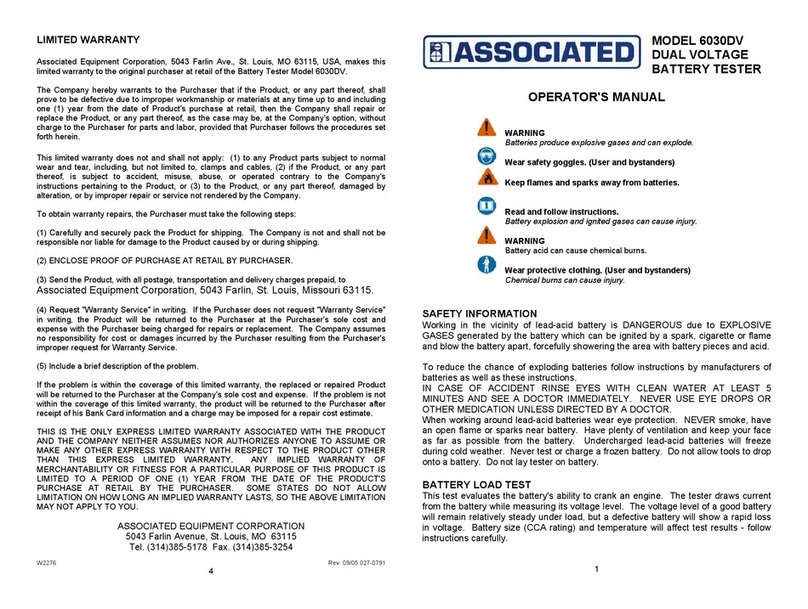
(BESA-12V24G) User Manual Version GS 17628
4
Version GS 17628
Unfiltered [pulsating DC] electricity can damage expensive electronic components, e.g., emissions
computer, radio, charging system, etc.
Turn off all electrical switches and components; turn off the ignition before disconnecting the battery.
•For non-sealed batteries, check the electrolyte level. Make sure it is covering the plates and it is not
frozen before starting to recharge (especially during winters).
•Do not add distilled water if the electrolyte is covering the top of the plates because during the recharging
process, it will get warm and expand. After recharging has been completed, recheck the level.
•Do NOT smoke or cause sparks or flames while the battery is being recharged because batteries give off
explosive gasses.
Preparing for Test:
1. The Battery Analyser operating voltage is from 9V to 36V DC. For Battery and Grounding tests on 24V
system (12V x 2 batteries connected in series), disconnect the connection between each battery and
clamp the analyser clips to one battery at a time and test them individually. For Starter Test (Cranking)
and Alternator Test (Charging), these tests can be done on 12V or 24V system.
2. Battery that has just been charged by the charger contains surface charge and it should be discharged by
turning ON the Head lights for 3~5 minutes before testing.
3. Always attached the tester clips on the lead side of the battery terminal posts during testing so that it has
a good contact. This will provide better and accurate results.
4. Do not attach the tester clips directly onto the steel bolt that tightened to the battery terminal posts; this
may give inaccurate readings or inconsistent results. (Note: This also applies to all other battery testing
methods.)
5. During testing on the battery whist it is still in the car, make sure the engine, all accessories and load are
OFF. Close the trunk lid and all doors.
6. Inspect the battery for cracks or broken casing. Do not use the Tester if the battery is damaged.
7. If the battery is a WET type: non sealed maintenance free, top up the level as specified by the markings
on the battery with distilled water. This will help to purge the gas from the cells. DO NOT OVERFILL.
8. If necessary to remove the battery from the vehicle to test, ALWAYS remove the negative terminal from
the battery first. Make sure all accessories are OFF so that you do not cause any arcing.
Initial Setup
Printer paper installation:
Open the printer cover by pushing it upwards from the middle. Place the roll of thermal paper into the slot with the
paper edge facing up (Fig. 1). Make sure the paper is about 1.0 inch (25.4 mm) out when the printer cover is
closed (Fig. 2).































